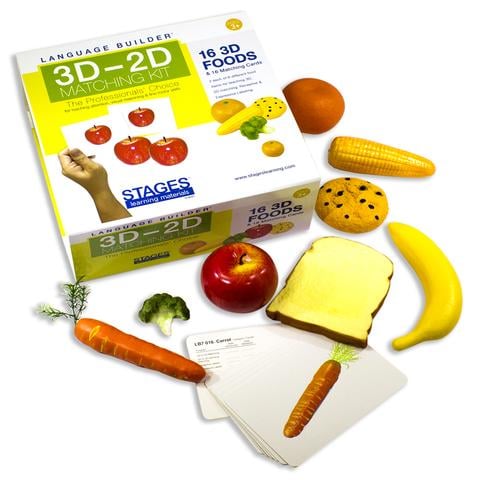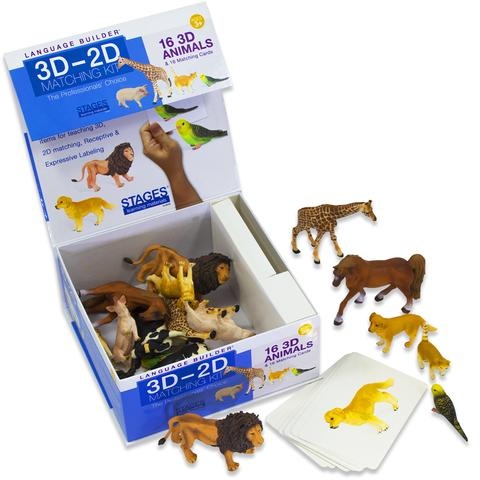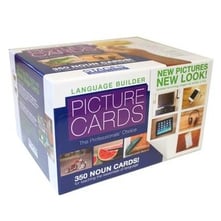Basic Matching Activities
Why Matching Activities for Children with Autism?
|
Note: These activities are excerpted from the Language Builder® ARIS Full Autism Curriculum developed by Stages Learning Materials. |
What does matching teach a child? How can this be a step toward developing language? Matching skills are essential for language development for children with autism.
In ABA therapy matching skills typically follow a hierarchy from the easiest and most accessible matching activities using identical physical objects to the more complex and abstract notion of matching representations of objects, such as those found in specially designed picture cards. As the child advances in matching activities they are able to connect physical objects with cards that represent the objects: A big leap forward in the development of language skill learning! Research demonstrates that using a progression of matching activities using ABA therapy techniques provides children with scaffolding needed to develop language skills.
Stages Learning Materials has created Language Builder® Matching Kits specially designed to foster identical and similar matching activities using objects and cards. The Language Builder® series is used widely by researchers and ABA therapists.
|
The Hierarchy of Matching Activities
Choose a 3D object to start with. Bowls and Cups, as offered in the Everyday Object Matching Kit are often a good first choice because they “nest,” which is a natural motivator for students to stack them together. Alternatively start with an object that is attractive or motivating to your particular student. If your student tends to engage in wheel-spinning stimulatory behavior, you may not want to start with wheeled vehicles.
Once the student has mastered matching one object, you can then move through the list of identical objects to match. As the student becomes more competent matching identical objects in a field of one, you can then add more objects to the field so the student will have to scan the objects before matching.
Choose a 3D object to start with. The Language Builder® 3D - 2D Matching Kits, such as the Food or Animal kits, are perfect for this matching activity. Start with an object that is attractive or motivating to your particular student. It is a good idea to choose an object with which your student has had significant success matching in the 3D - 3D matching activity.
Once the student has mastered matching one object to the corresponding photo card, you can then move through the list of identical objects to match. As the student becomes more competent matching object to card in a field of one, you can then add more objects to the field so the student will have to scan the objects before matching. There are additional lessons designed for 3D - 2D matching at the end of this article.
Choose a card from the Language Builder® Picture Nouns set to start. Begin with a card that has an image that is attractive or motivating to your particular student. It is a good idea to choose an object with which your student has had significant success matching in the 3D - 3D, and 2D - 3D matching activities.
Once the student has mastered matching one photo card to the corresponding photo card, you can then ask the student to match other identical pictures. As the student becomes more competent matching card to card in a field of one, you can then add more cards to the field so the student will have to scan the cards before matching.
Choose a card from the Language Builder® Picture Nouns set to start. Begin with a card that has an image that is attractive or motivating to your particular student. It is a good idea to choose an object with which your student has had significant success with in previous matching activities.
Once the student has mastered matching one photo card to the corresponding similar photo card, you can then ask the student to match other similar pictures. As the student becomes more competent matching card to card in a field of one, you can then add more cards to the field so the student will have to scan the cards before matching |
Research on Matching: 3D - 2D is Essential
Basic matching is one of the first lessons taught in an Applied Behavioral Analysis (ABA) program for children with autism. Teaching early language skills to children with autism often begins with having children match identical objects. Before a child can learn that the picture of an object actually represents a real item (picture-object correspondence), the child may need to start learning by matching actual physical objects. It is often necessary to start by matching 3D objects such as cups or toy cars and later transition to matching identical images on cards (Blumberg & Hurley, 2007).
Teaching daily living skills to children with autism often depends on using activity schedules and sequencing charts. These tools are effective only at the point at which children have mastered the prerequisite skills of matching a 2D image to a 3D object (Haas, 2011). Until a child has the capacity to understand that a 2D image such as a picture of a toothbrush represents an actual object, being able to prompt a child to engage in brushing their teeth cannot be accomplished using an activity schedule or card. Some children will eventually be able to move from seeing an actual toothbrush, to recognizing a card that has a photographic image of a toothbrush, to recognizing the word “toothbrush.” Other children with more severe language delays will only be able to respond to 3D prompts (Baynham, 2007).
The Research Connection Between Matching Activities and Language Development
 In a study using different types of photographs, symbols, and objects to teach language skills to 40 non-verbal subjects with autism the real objects proved to be much more readily recognized than any of the other representations of objects (Mirenda & Locke, 1989).
In a study using different types of photographs, symbols, and objects to teach language skills to 40 non-verbal subjects with autism the real objects proved to be much more readily recognized than any of the other representations of objects (Mirenda & Locke, 1989).
Typically developing infants and children under the age of three also learn from viewing 3D objects and often cannot process a 2D picture of an object until a later age. Researchers testing 5-month-old infants found that these infants could not understand 2-D images, but when presented with the same content in 3D representations infants were able to understand the objects. The researchers found that by examining 3D objects children naturally learn about objects in their world and that being able to examine a 3D object provides additional sensory information rather than just viewing a 2D image on a card (Mash & Boornstein, 2012).
The following are resources that can help support basic matching activities to promote language development:
Lesson Plans:
- Mastering Matching 3D - 2D
- Storytelling and Recall with Animals (3D - 2D Matching)
- Using Identical Matching to Teach Beginning Language Skills to Children with Autism
Resources for Matching Activities
- LB6 Language Builder®: Blocks
- LB7 Language Builder®: 3D-2D Matching Kit: Foods
- LB8 Language Builder®: 3D-2D Matching Kit: Animals
- LB9 Language Builder®: 3D-2D Matching Kit: Everyday Objects
- LB10 Language Builder®: 3D-2D Matching Kit: Vehicles
Stages also offers 10 Memory Card Games that teach matching skills
References to Research on Matching and Language Development
Baynham, Tanya Yvonne. (2007). Training a non-match response: Toward a technology for determining controlling stimulus dimensions for two children with autism. University of North Texas, Dissertation. ProQuest Dissertations Publishing.
Blumberg, E.R. & Hurley, E. (2007). Enhancing Early Intervention for Parents of Young Children with Autism Spectrum Disorders: Information, Strategies, & Resources. New Brunswick, NJ: The Elizabeth M. Boggs Center on Developmental Disabilities.
Haas, Stephanie Iwanciow. (2011). “Teaching daily living skills to young adults with autism: the creation of a curriculum guide for special education teachers.” California State University: M.A. Thesis. Available: http://digitalcommons.csumb.edu/caps_thes/426
Mash, C., & Bornstein, M. H. (2012). 5-month-olds’ categorization of novel objects: Task and measure dependence. Infancy, 17, 179-197.
Mirenda, P., & Locke, P. (1989). A comparison of symbol transparency in nonspeaking persons with intellectual disabilities. Journal of Speech and Hearing Disorders, 54, 131-140.

Angela Nelson, J.D., Ed.M.
Angela Nelson is the creator of the widely-recognized Language Builder Picture Card Series, and the creator and lead author for the Language Builder ARIS curriculum. Angela received her BA and JD from UCLA where she studied and practiced behavior psychology under Dr. Ivar Lovaas, and her Ed.M. at the Harvard Graduate School of Education, with a focus on technology innovation and education. As Founder and CEO of Stages Learning Materials, Angela has created autism, special needs and early childhood curriculum products since 1997. In addition to her duties at Stages, Angela writes for multiple industry publications and is Chair of the Education Market Association.








